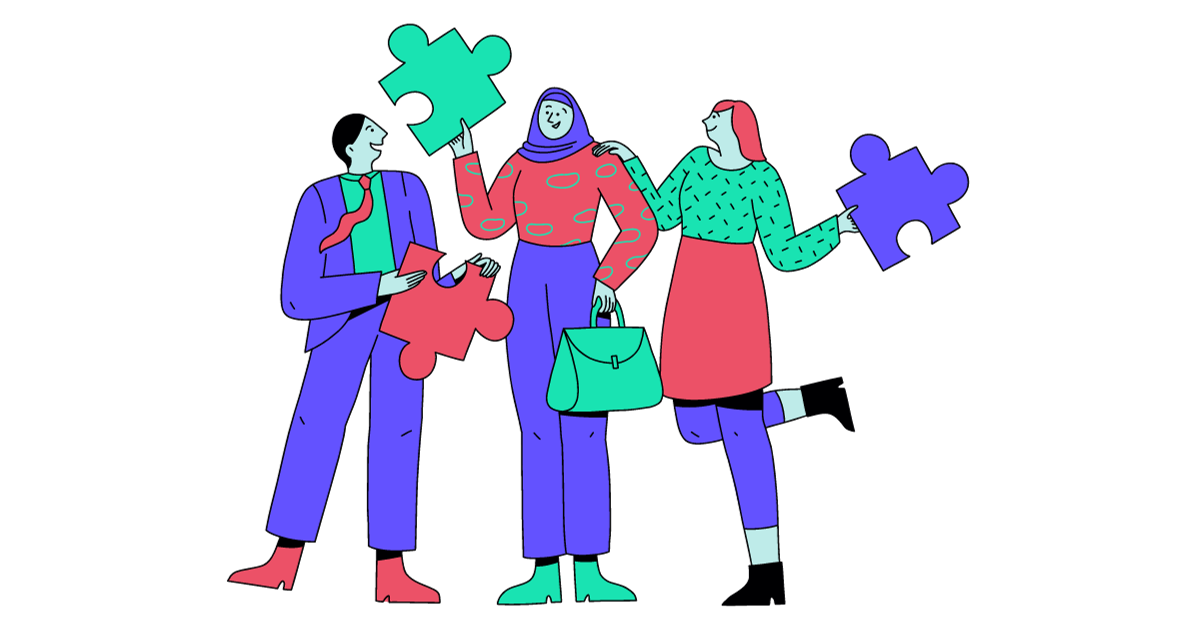Diversity and inclusion acronyms can vary between contexts, countries, and identities. With over 2.5 billion results on Google search, the most common acronym is DEI, meaning Diversity, Equity, and Inclusion. Other common acronyms include DEIB and D&I, with 12 million and 9 million search results respectively. (We use DEIB, for Diversity, Equity, Inclusion, and Belonging, ourselves – but more on that later.) Yet another one of the diversity and inclusion acronyms you might encounter is JEDI; search “jedi” though, and Google results will return pictures of Yoda from Star Wars movies.
As diversity and inclusion acronyms become part of our daily lexicon, it’s important to know their standard definitions. This article will explain the meaning and intention behind these different acronyms, touch upon different identity-related acronyms, and provide a quick-reference glossary.
DEIB, JEDI, D&I and DEI acronyms
Organizational leaders need to be equipped with the right diversity and inclusion acronyms for the workplace in order to understand and speak about these topics with authority. There are different acronyms you can use to express a variety of goals and key emphases within your efforts to build an inclusive workplace.
DEI: Diversity, Equity, and Inclusion
Today, DEI is the most widely used diversity and inclusion acronym.
Diversity means understanding that each individual is unique, with their own identities, beliefs, perspectives, and background — both seeing and valuing those differences.
Equity is when each person is allocated resources and opportunities based on their circumstances in order to reach an equal outcome. Equity is based on the idea that people have different circumstances, needs, and levels of access; thus, what one person needs may vary greatly from another person’s needs. This differs from equality, where each individual or group is given the same resources and opportunities, no matter their needs or level of access.
Inclusion is the state of being valued, respected, and supported. In the workplace, inclusion makes diversity meaningful. Working towards inclusion means acknowledging that people need different conditions to achieve their full potential and ensuring those conditions are in place. It eliminates tokenism, because intentional inclusion allows for authenticity and uniqueness.
DEIB: What is belonging?
Here at PowerToFly, we use the acronym DEIB: Diversity, Equity, Inclusion, and Belonging. Belonging is a person’s perception of acceptance within a given group. A sense of belonging is critical to family and friend groups. At work, fostering belonging means that people of all backgrounds get a seat at the table and feel heard, seen, and recognized for their contributions.
Adding the “B” to DEIB recognizes that a sense of belonging improves employees’ personal feelings of positivity. This term has been used by academic institutions at the forefront of diversity research, such as the University of California at Berkeley, since 2020. Belonging is recognized as part of an overall strategy to deepen inclusion and invite acknowledgement, acceptance, and authenticity for all in the workplace. As a result, DEIB is becoming a more popular acronym.
D&I
D&I is the acronym for Diversity and Inclusion, and has been around longer than the others on this list. While some people still use D&I as an acronym for diversity work, DEI or, increasingly, DEIB is more common. This is because equity is widely accepted as a crucial concept and element of DEI or DEIB work.
EDI
The acronym EDI has been adopted in some countries, like parts of Canada and the U.K., for Equity or Equality, Diversity, and Inclusion. The idea here was to intentionally place Equity or Equality ahead of Diversity and Inclusion.
DEIA
This diversity and inclusion acronym stands for: Diversity, Equity, Inclusion, and Access (or Accessibility). Some folks also use this acronym with “A” meant to represent Anti-Racist. In the U.S., the former appears most common in relation to government programming and policies. For instance, in 2021, an Executive Order on Diversity, Equity, Inclusion and Accessibility in the Federal Workforce was released by President Biden to advance all four areas for federal employees. That order defined Accessibility as: “The design, construction, development, and maintenance of facilities, information and communication technology, programs, and services so that all people, including people with disabilities, can fully and independently use them.”
JEDI: What is justice?
JEDI means Justice, Equity, Diversity, and Inclusion. Justice occurs when people have the resources they need, systemic inequalities are removed, and past wrongs have been rectified. In a foot race, equity would be giving someone better shoes (tools) because they have to start farther back. Justice would be fixing the inherent inequalities of the race (blind parameters) so that everyone starts at the same starting line. Justice can also mean vocally acknowledging the fact that before the race’s inequalities were fixed, there were many participants who were unfairly held back, and seeking to address those wrong. Justice is the realization of full equity. Like DEIB, the JEDI acronym began to be more widely seen in and after 2020.
When it comes to choosing an acronym to represent your organization’s efforts in this space (more on that below), our advice is: be specific and say what you mean. Don’t use the acronym DEIB or JEDI just because you want to sound current if your company doesn’t, or isn’t equipped to, embed Belonging or Justice into its goals and policies. At PowerToFly, for example, we know that DEIB accurately reflects our emphasis on helping company leaders create deeper senses of belonging at their organizations.
Identity-related acronyms for diversity
Leaders at organizations will encounter a multitude of diversity and inclusion-related acronyms as they move deeper into their initiatives. Here are some common terms:
BIPOC. This acronym means Black, Indigenous, and (other) People of Color. BIPOC has generally replaced the widely used term “people of color (PoC),” which some criticized for being imprecise and centering Whiteness as the default. Whenever possible, use specific terms to refer to groups of people (ex. Filipino-Americans versus Asian-Americans or Asians).
BAME. This term means Black, Asian, and Minority Ethnic. It is commonly used in the UK, where it’s also criticized by some corners of these communities.
MENA. This means Middle Eastern and North African, including folks from countries as far west as Morocco and as far east as Iran. The MENA label is “considered the most inclusive term because it includes non-Arab countries and non-Arab ethnic groups within the MENA region,” according to 2021 research on the self-labeling of Americans of MENA descent.
AAPI. Asian/Asian American or Pacific Islander (AAPI): This includes individuals who have origins in Central Asia, East Asia, Southeast Asia, South Asia, Hawaii, and the Pacific Islands.
LGBTQIA+. This stands for lesbian, gay, bisexual, transgender, queer or questioning, intersex, asexual, and limitless possibility. Longer versions, such as LGBTQQIP2SAA, exist to emphasize inclusivity under the queer umbrella.
ASD. Autism Spectrum Disorder is a developmental condition that affects how people interact with others, learn, communicate, and behave. Generally, the terms “autistic adult/child/person” or “is on the autism spectrum” are acceptable phrases to use.
ENBY, NB, NBi. An umbrella term for people whose gender identity doesn’t sit comfortably with “man” or “woman.” Nonbinary identities are varied and can include people who identify with some aspects of binary identities, while others reject them entirely. (Note: Given that NB was first used by Black folks online as a way to refer to non-Black individuals, some are calling for use of the other two versions of this acronym only.)
AFAB/AMAB. Acronyms meaning “assigned female/male at birth” to describe the sex assigned to a trans or nonbinary person when they were born. Note that some trans people may not be comfortable with references to their previously assigned gender.
ND. This acronym means “neurodivergent.” Neurodiversity refers to the concept that people think, interact with, and process the world around them in different and unique ways. The term was coined in 1997 by sociologist Judy Singer. Neurodiversity is most often used to refer to people with Autism Spectrum Disorder (ASD), which is a form of neurodivergence. However, the neurodiversity umbrella includes other neurodivergent folks, too, like those with attention deficit hyperactivity disorder (ADHD), dyslexia, dyspraxia, obsessive compulsive disorder (OCD), and others.
NT. Meaning “neurotypical.” Describes a person whose neurological development and state are “typical,” conforming to what most people would perceive as ‘“normal.”
IFL. This means “identity-first language.” When referring to a person or group of people, IFL will place the identity at the beginning: “I am a disabled person.” In some communities, IFL may be preferred.
PFL. This means “person-first language,” and it places the person or people at the beginning of a descriptive phrase: “I am a person with a disability.” While some people prefer identity-first language, person-first is a reasonable default. When referring to a specific person or group, always use their preferred terms.
Glossary of diversity vocabulary words
This is a quick-reference of other acronyms and words associated with diversity and inclusion.
- ADA - Americans with Disabilities Act
- AAVE - African American Vernacular English
- CSR - Corporate Social Responsibility
- EEO - Equal Employment Opportunity
- ESL - English as a Second Language
- ELL - English Language Learner
- ERG - Employee Resource Group
- GEI - Bloomberg Gender Equality Index
- GSD - Gender and Sexual Diversity
- HBCU - Historically Black Colleges and Universities
- RJ - Restorative Justice
- SDG - Sustainable Development Goals
- STEM - Science, Technology, Engineering, and Math
- UG - Underrepresented Groups
- URM - Underrepresented Minority
What to do when you don’t know a DEIB acronym
There is no shame in not knowing an acronym when it’s thrown out in a meeting. Quite the opposite. Curiosity, humility, and a desire for learning are critical qualities to have in DEIB work.
Try saying, “I’m sorry, can you explain that acronym?” or “I’m sorry, I don’t know what [acronym] means. Can you define it?”
DEI, DEIB, JEDI, D&I, DEIA: Which one is right for our company?
In the end, these diversity and inclusion acronyms are an expression of goals and focus. If you’re deciding which acronym you want to use, ask yourself or your team what is important. Do you want to focus on Justice or Belonging and stick with the cutting edge of thought leadership? Or is it better to use more established corporate terms like DEI? Either way, don’t hesitate to ask for an explanation of a diversity and inclusion acronym you don’t know. Learning is the most important part of the DEIB process.




